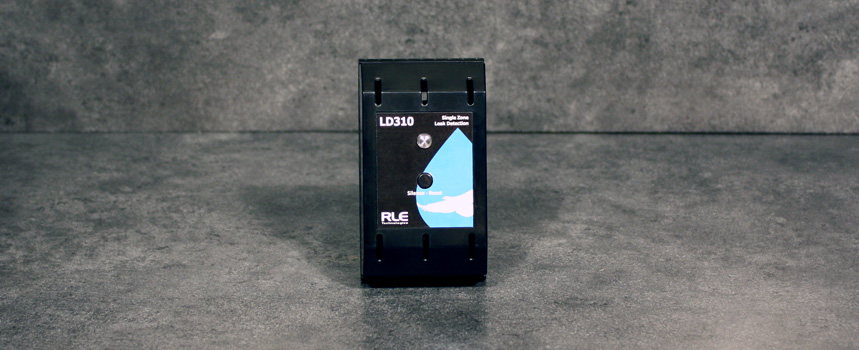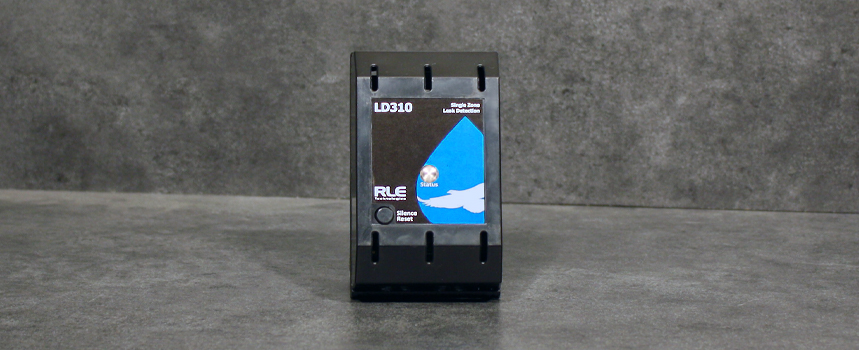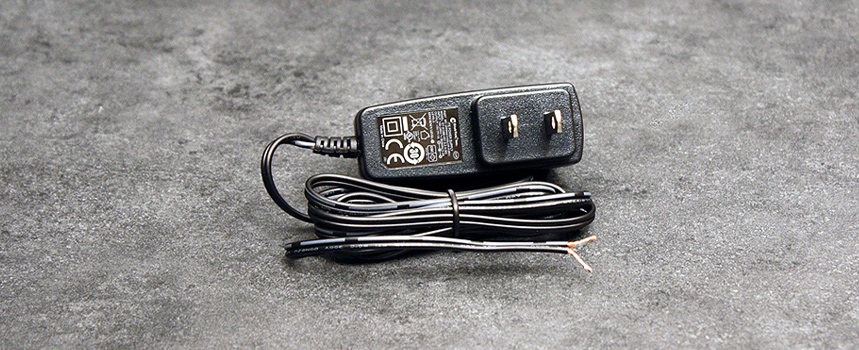The SeaHawk LD310 single zone leak detection controller monitors up to 300 feet (91 meters) of sensing cable. It is compatible with all of RLE’s leak detection sensing cables, as well as SD-Z and SD-Z1 spot detectors.
When your system is in alarm, the LD310 will notify you via:
- Audible alarm
- Visible LED
- Leak and fault relay outputs
Where Should You Use The LD310?
Ideal for smaller areas and facilities, the LD310 can act as a stand-alone controller or integrate into existing monitoring systems. The LD310 is most commonly installed in facilities with pumps, chillers, boilers, water control valves, and around air conditioner condensation pans.
How Much Cable Do I Need?
Ready to purchase a SeaHawk system? Download and use our SeaHawk Sensing Cable Length Calculator to make sure you order the right amount of cable.
Make Sure You Have An Isolated Power Supply!
RLE leak detection controllers, including the LD310, require an isolated power supply. A power supply is not included with the LD310. Purchase RLE’s WA-DC-5-ST power supply.
Click here for more information about RLE leak detection controllers and isolated power supplies.
Key Features
- Accommodates up to 300 feet (91 meters) of sensing cable and/or spot detectors, or
- Visible alarm indicator
- Two Form C output relays for leak and fault alarms
- Audible and visible alarm notification
- Adjustable leak alarm sensitivity thresholds
- Configurable for supervised or non-supervised operation
- Distinguishes normal conditions from alarm conditions
- Quickly returns to normal
LD310 Specifications
Included Equipment: LD310 controller, leader cable, end-of-line (EOL) terminator
Additional Requirements: Power supply WA-DC-5-ST, sensing cable and spot detector (as needed for application)
Power: Requires an isolated power supply.
- 5VDC Isolated (±10%) @ 100mA max; requires RLE power supply WA-DC-5-ST (not included)
Inputs
- Leak Detection Cable: Compatible with all SeaHawk sensing cables as well as SD-Z and SD-Z1 spot detectors (not included)
- One Cable Input: Requires 15ft (4.6m) leader cable and EOL terminator (included)
- Maximum Sensing Cable Length: 300ft (91m) of sensing cable
- Detection Response Time: When used with sensing cables, less than 20sec; 10sec typical.
Outputs: 2 Form C Alarm Relays (leak and fault); 1A @ 24VDC, 0.5A resistive @ 120VAC; configurable as supervised or non-supervised
Alarm Notification
- Audible Alarm: 85dB @ 10cm (min)
- Visual Alarm: Bi-color LED
Front Panel Interface
- Audible Alarm: Indicates cable break or leak detected
- LED Indicator:
- Normal Operation: Green
- Cable Fault: Flashing orange
- Leak Detected: Flashing red
- Push Button Switch:
- Push Once: Silence alarm
- Push and Hold for 5 Seconds: Initiates system test, resets system, clears all active alarms
Operating Environment
- Temperature: 32° to 122°F (0° to 50°C)
- Humidity: 5% to 95% RH, non-condensing
- Altitude: 15,000ft (4,572m) max.
Storage Environment: -4° to 158°F (-20° to 70°C)
Dimensions: 4.4”L x 2.5”W x 1.5”H (11.2cmL x 6.4cmW x 3.8cmH)
Weight: 0.2lb (0.10kg)
Mounting: Free standing, zip ties, screw and keyhole – spaced 2.5” (6.4cm), junction box – 2 screws spaced 3.28” (8.3cm)
Certifications: CE; ETL listed: conforms to UL 61010-1, EN 61010-1; RoHS compliant
Product Documentation Links
Technical Resources
Technical Notes
Use the Right Power Supply
The LD310 requires an isolated 5VDC power supply. A power supply is not included with the LD310. Purchase RLE power supply WA-DC-5-ST with the LD310.
Supervised vs. Non-supervised Relays
Wondering about the relay on the LD310? It’s the question we hear most often. Here’s what you’ll need to know:
- If the relay is supervised:
The relay remains ON until either power is disabled or an alarm is detected – at which time the relay turns OFF.
- If the relay is non-supervised:
The relay remains OFF until an alarm is detected – at which time the relay turns ON.
Adjust DIP switch SW2.1 (or jumper JP2 on some models) to make the relay output supervised or non-supervised. You’ll notice that, by default, the relay is configured as non-supervised.
** If you change the settings, you must cycle power to the unit in order for it to recognize the change. **




